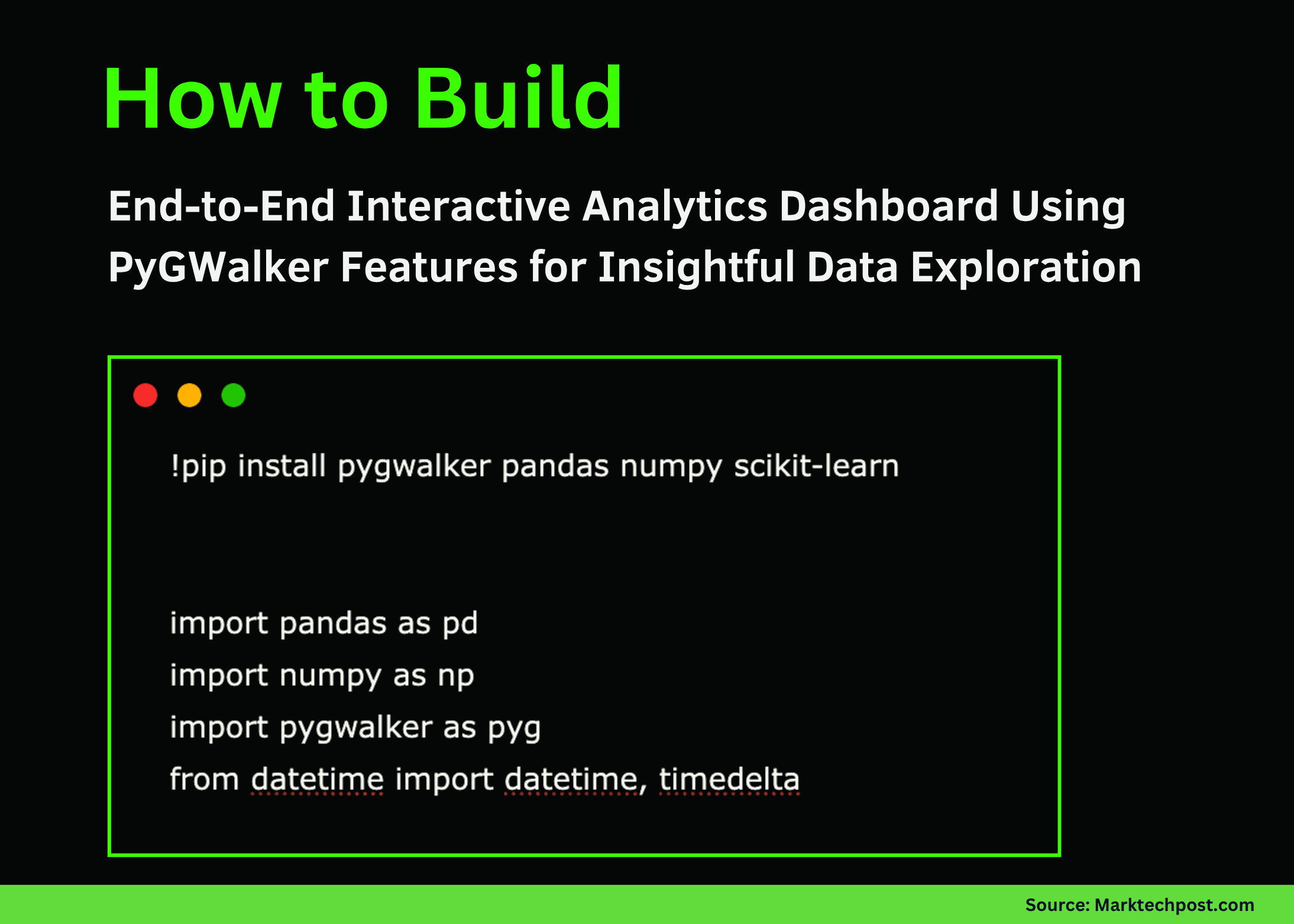How to Build an End-to-End Interactive Analytics Dashboard Using PyGWalker Features for Insightful Data Exploration

def generate_advanced_dataset():
np.random.seed(42)
start_date = datetime(2022, 1, 1)
dates = [start_date + timedelta(days=x) for x in range(730)]
categories = [‘Electronics’, ‘Clothing’, ‘Home & Garden’, ‘Sports’, ‘Books’]
products = {
‘Electronics’: [‘Laptop’, ‘Smartphone’, ‘Headphones’, ‘Tablet’, ‘Smartwatch’],
‘Clothing’: [‘T-Shirt’, ‘Jeans’, ‘Dress’, ‘Jacket’, ‘Sneakers’],
‘Home & Garden’: [‘Furniture’, ‘Lamp’, ‘Rug’, ‘Plant’, ‘Cookware’],
‘Sports’: [‘Yoga Mat’, ‘Dumbbell’, ‘Running Shoes’, ‘Bicycle’, ‘Tennis Racket’],
‘Books’: [‘Fiction’, ‘Non-Fiction’, ‘Biography’, ‘Science’, ‘History’]
}
n_transactions = 5000
data = []
for _ in range(n_transactions):
date = np.random.choice(dates)
category = np.random.choice(categories)
product = np.random.choice(productsAI Shorts)
base_prices = {
‘Electronics’: (200, 1500),
‘Clothing’: (20, 150),
‘Home & Garden’: (30, 500),
‘Sports’: (25, 300),
‘Books’: (10, 50)
}
price = np.random.uniform(*base_pricesAI Shorts)
quantity = np.random.choice([1, 1, 1, 2, 2, 3], p=[0.5, 0.2, 0.15, 0.1, 0.03, 0.02])
customer_segment = np.random.choice([‘Premium’, ‘Standard’, ‘Budget’], p=[0.2, 0.5, 0.3])
age_group = np.random.choice([’18-25′, ’26-35′, ’36-45′, ’46-55′, ’56+’])
region = np.random.choice([‘North’, ‘South’, ‘East’, ‘West’, ‘Central’])
month = date.month
seasonal_factor = 1.0
if month in [11, 12]:
seasonal_factor = 1.5
elif month in [6, 7]:
seasonal_factor = 1.2
revenue = price * quantity * seasonal_factor
discount = np.random.choice([0, 5, 10, 15, 20, 25], p=[0.4, 0.2, 0.15, 0.15, 0.07, 0.03])
marketing_channel = np.random.choice([‘Organic’, ‘Social Media’, ‘Email’, ‘Paid Ads’])
base_satisfaction = 4.0
if customer_segment == ‘Premium’:
base_satisfaction += 0.5
if discount > 15:
base_satisfaction += 0.3
satisfaction = np.clip(base_satisfaction + np.random.normal(0, 0.5), 1, 5)
data.append({
‘Date’: date, ‘Category’: category, ‘Product’: product, ‘Price’: round(price, 2),
‘Quantity’: quantity, ‘Revenue’: round(revenue, 2), ‘Customer_Segment’: customer_segment,
‘Age_Group’: age_group, ‘Region’: region, ‘Discount_%’: discount,
‘Marketing_Channel’: marketing_channel, ‘Customer_Satisfaction’: round(satisfaction, 2),
‘Month’: date.strftime(‘%B’), ‘Year’: date.year, ‘Quarter’: f’Q{(date.month-1)//3 + 1}’
})
df = pd.DataFrame(data)
df[‘Profit_Margin’] = round(df[‘Revenue’] * (1 – df[‘Discount_%’]/100) * 0.3, 2)
df[‘Days_Since_Start’] = (df[‘Date’] – df[‘Date’].min()).dt.days
return df
np.random.seed(42)
start_date = datetime(2022, 1, 1)
dates = [start_date + timedelta(days=x) for x in range(730)]
categories = [‘Electronics’, ‘Clothing’, ‘Home & Garden’, ‘Sports’, ‘Books’]
products = {
‘Electronics’: [‘Laptop’, ‘Smartphone’, ‘Headphones’, ‘Tablet’, ‘Smartwatch’],
‘Clothing’: [‘T-Shirt’, ‘Jeans’, ‘Dress’, ‘Jacket’, ‘Sneakers’],
‘Home & Garden’: [‘Furniture’, ‘Lamp’, ‘Rug’, ‘Plant’, ‘Cookware’],
‘Sports’: [‘Yoga Mat’, ‘Dumbbell’, ‘Running Shoes’, ‘Bicycle’, ‘Tennis Racket’],
‘Books’: [‘Fiction’, ‘Non-Fiction’, ‘Biography’, ‘Science’, ‘History’]
}
n_transactions = 5000
data = []
for _ in range(n_transactions):
date = np.random.choice(dates)
category = np.random.choice(categories)
product = np.random.choice(productsAI Shorts)
base_prices = {
‘Electronics’: (200, 1500),
‘Clothing’: (20, 150),
‘Home & Garden’: (30, 500),
‘Sports’: (25, 300),
‘Books’: (10, 50)
}
price = np.random.uniform(*base_pricesAI Shorts)
quantity = np.random.choice([1, 1, 1, 2, 2, 3], p=[0.5, 0.2, 0.15, 0.1, 0.03, 0.02])
customer_segment = np.random.choice([‘Premium’, ‘Standard’, ‘Budget’], p=[0.2, 0.5, 0.3])
age_group = np.random.choice([’18-25′, ’26-35′, ’36-45′, ’46-55′, ’56+’])
region = np.random.choice([‘North’, ‘South’, ‘East’, ‘West’, ‘Central’])
month = date.month
seasonal_factor = 1.0
if month in [11, 12]:
seasonal_factor = 1.5
elif month in [6, 7]:
seasonal_factor = 1.2
revenue = price * quantity * seasonal_factor
discount = np.random.choice([0, 5, 10, 15, 20, 25], p=[0.4, 0.2, 0.15, 0.15, 0.07, 0.03])
marketing_channel = np.random.choice([‘Organic’, ‘Social Media’, ‘Email’, ‘Paid Ads’])
base_satisfaction = 4.0
if customer_segment == ‘Premium’:
base_satisfaction += 0.5
if discount > 15:
base_satisfaction += 0.3
satisfaction = np.clip(base_satisfaction + np.random.normal(0, 0.5), 1, 5)
data.append({
‘Date’: date, ‘Category’: category, ‘Product’: product, ‘Price’: round(price, 2),
‘Quantity’: quantity, ‘Revenue’: round(revenue, 2), ‘Customer_Segment’: customer_segment,
‘Age_Group’: age_group, ‘Region’: region, ‘Discount_%’: discount,
‘Marketing_Channel’: marketing_channel, ‘Customer_Satisfaction’: round(satisfaction, 2),
‘Month’: date.strftime(‘%B’), ‘Year’: date.year, ‘Quarter’: f’Q{(date.month-1)//3 + 1}’
})
df = pd.DataFrame(data)
df[‘Profit_Margin’] = round(df[‘Revenue’] * (1 – df[‘Discount_%’]/100) * 0.3, 2)
df[‘Days_Since_Start’] = (df[‘Date’] – df[‘Date’].min()).dt.days
return df













